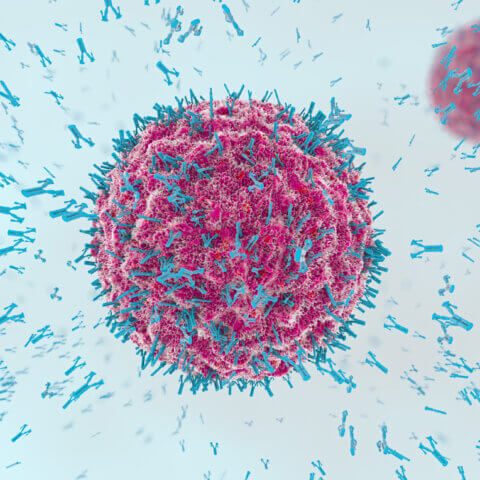In this era of precision medicine, biomarkers play a critical role in the rational development of novel therapies. With advances in both our understanding of cancer pathophysiology and tumor profiling technology, biomarkers can now be used to provide important insights at every stage of drug discovery and development. In this article, we explore the common applications of biomarkers in oncology, with a focus on companion diagnostics and key considerations for incorporating biomarkers into clinical development programs.
Defining Biomarkers
According to the National Cancer Institute, a biomarker is a “biological molecule found in blood, other bodily fluids, or tissues that is a sign of a normal or abnormal process, or of a condition or disease….[and] may be used to see how well the body responds to a treatment for a disease or condition.”1 In 2016, as part of their joint Biomarkers, EndpointS, and other Tools (BEST) resource, the U.S. Food and Drug Administration and the National Institutes of Health established definitions to clarify the application of biomarkers in research and clinical practice.2 Among the many subtypes of biomarkers, the most commonly used in oncology clinical development are:
- Diagnostic biomarkers, which detect or confirm the presence of a disease or condition of interest or identify an individual with a subtype of the disease3
- Predictive biomarkers, which are used to identify those who are more likely to experience either a favorable or unfavorable effect from exposure to a medical product3
- Prognostic biomarkers, which identify the likelihood of a clinical event, disease recurrence or progression in individuals with a disease or condition of interest3
Companion Diagnostics
While significant progress has been made in our understanding of the complex biology of cancer, most approved oncology drugs vary in degree or duration of efficacy among different subsets of patients. The objective of precision medicine is to direct therapies to patients who are most likely to experience a positive benefit-risk profile with a targeted drug while reducing unnecessary exposure to patients who are unlikely to respond. When a biomarker test is used to provide information that is essential for the safe and effective use of a corresponding therapeutic, it is called a companion diagnostic (CDx). The term complementary diagnostic refers to an assay that may inform on improving the benefit-risk ratio of a therapeutic without restricting access to it. Typically, that therapeutic has been shown to benefit all patients, regardless of biomarker status, but may offer enhanced benefits in certain subgroups.
A Brief History of Companion Diagnostics in Oncology
The shift to targeted therapy began in the early 1970s when a failed antiestrogen contraceptive was reinvented as tamoxifen. Building on a long-established link between hormones and breast cancer growth, research throughout the 1970s showed the potential of this antihormonal therapy in estrogen receptor-positive breast cancer.4 In 1977, tamoxifen was approved for patients with advanced breast cancer and, since then, it has become the gold standard for patients with estrogen receptor-positive breast cancer.5 In the late 1980s, it was reported that amplification of the human epidermal growth factor receptor 2 (HER2) gene was associated with poor prognosis in a subgroup of women with breast cancer. This sparked the development of trastuzumab (Herceptin), an anti-HER2 monoclonal antibody, in the 1990s. Studies showed that patients who overexpress the HER2 protein experienced clinically meaningful responses to Herceptin, leading to the development of validated assays for HER2 expression. In 1998, the FDA simultaneously granted approval to both Herceptin and HercepTest™, the first CDx.6 HercepTest has thus paved the way for a strategic drug-diagnostic co-development model which has become increasingly common over the past two decades.
Over the past 20 years, a number of drug-diagnostic combinations have obtained regulatory approval (see Figure 1). As of August 2022, there are 145 cleared or approved CDx, all but two of which are for oncology indications, reflecting the great strides that have been made in the development of targeted cancer therapies. In recent years, the FDA has approved several CDx across multiple cancer types and therapies. For example, FoundationOne®CDx has been approved as a CDx for more than 20 different drugs. The FDA has also approved group labeling for both FoundationOne®CDx and cobas EGFR Mutation Test v2, where the indication is for a specific group of oncology therapeutic products rather than a single drug.5
Figure 1. Key Companion Diagnostic Approvals
| Year | Drug | Diagnostic | Indication |
| September 1998 | Trastuzumab (Herceptin) | HercepTest | Breast cancer |
| February 2004 | Cetuximab (Erbitux) | Dako EGFR pharmDx Kit | Colorectal cancer |
| December 2014 | Olaparib (Lynparza) | BRACAnalysis CDx | Breast cancer |
| October 2015 | Pembrolizumab (Keytruda) | PD-L1 IHC 22C3 pharmDx | Non-small cell lung cancer |
| April 2016 | Venetoclax (Venclexta) | Vysis CLL FISH Probe Kit | B-cell chronic lymphocytic leukemia |
| December 2016 | Rucaparib (Rubraca) | FoundationFocus CDxBRCA Assay | Ovarian cancer |
| December 2017 | Nilotinib (Tasigna) | MRDx BCR-ABL Test | Chronic myeloid leukemia |
| December 2019 | Olaparib (Lynparza) | FoundationOne CDx | Ovarian cancer |
| June 2020 | Tazemetostat (Tazverik) | Cobas EZH2 Mutation Test | Follicular lymphoma |
| October 2020 | Larotrectinib (Vitrakvi) | FoundationOne CDx | Solid tumors |
| May 2021 | Amivantamab (Rybrevant) | Guardant360 CDx | Non-small cell lung cancer |
| May 2021 | Sotorasib (Lumakras) | Guardant360 CDx | Non-small cell lung cancer |
Leveraging Biomarkers in Oncology Therapeutic Development
Industry focus on therapies targeted for specific populations has led to increased emphasis by researchers and regulatory agencies on biomarker-guided clinical trials and drug-diagnostic co-development. A recent study on clinical drug development success rates showed that, from 2011 to 2020, programs with trials using patient preselection (predictive) biomarkers had a two-fold higher likelihood of approval, primarily driven by a higher Phase 2 success rate.7
Biomarkers are now widely used at every stage of drug discovery and development. According to a recent analysis, ~55 percent of all clinical trials in 2018 involved the use of biomarkers. Among these trials, nearly half included two or more biomarkers.8 In addition to single-gene biomarker assays based on mutations in known oncogenes or tumor suppressor genes, complex genomic signatures and pan-tumor biomarkers are being used to guide clinical trials, a paradigm shift from traditional indication- or organ-specific approaches. The development of pembrolizumab, a human programmed death receptor-1 (PD-1)-blocking inhibitor, is a prime example of how biomarkers have been used to evaluate patients across tumor types. Since its initial approval for advanced melanoma in September 2014, pembrolizumab has been approved for over 40 indications and approval for some of these indications has been based on small, non-Phase 3 studies.9
The use of biomarkers has contributed to trends such as smaller trial sizes, novel study designs such as basket and umbrella trials or multi-agent master protocols, and accelerated approvals. Notably, of the breakthrough therapy designations granted by the FDA over the past few years, approximately two-thirds have been accompanied by a CDx.10 The last two decades have seen significant advancements in the use of companion diagnostics in oncology drug development, and with advancing technologies this field will continue to see even more growth going forward.
Key Considerations
Biomarker-guided trials can be complex and biomarker development can be costly, so proactive planning is essential. It is critical to tailor the trial design to answer the research question(s) being asked. Sponsors who are designing biomarker-guided trials or contemplating drug-diagnostic co-development will need to consider:
- Biomarker selection. When selecting biomarkers for a clinical trial, it is critical to establish or confirm the clinical relevance of that biomarker in the disease or condition of interest
- Purpose of the biomarker. How will biomarker data be used? The intended use of that data will inform the level of validation required for the biomarker assay in clinical trials
- Assay development. Will the same clinical trial assay be used across all sites and studies? If not, sponsors will need to understand any differences in what is detected by each of these assays
- Cost. Due to their complexity, biomarker-guided trials are often resource-intensive
- Regulatory issues. The landscape continues to evolve, and requirements are not harmonized across regulatory bodies
At Premier Research, our expertise in adaptive design methods, combined with our deep experience in oncology, regulatory strategy, and real-world late phase-programs, enables us to devise effective solutions for sponsors planning biomarker-guided trials.
[1] National Cancer Institute. Biomarker. Available at https://www.cancer.gov/publications/dictionaries/cancer-terms/def/biomarker.
[2] Califf RM. Biomarker definitions and their applications. Exp Biol Med 2018;243(3):213-221.
[3] FDA-NIH Biomarker Working Group. BEST (Biomarkers, EndpointS, and other Tools) Resource, Silver Spring (MD): Food and Drug Administration (US); Bethesda (MD): National Institutes of Health (US); 2016-. Available at https://www.ncbi.nlm.nih.gov/books/NBK326791/.
[4] Jensen EV, Jordan VC. The estrogen receptor: a model for molecular medicine. Clin Cancer Res. 2003;9(6):1980-1989.
[5] Jordan CV. Tamoxifen: catalyst for the change to targeted therapy. Eur J Cancer. 2008;44(1):30-38.
[6] Scheerens H, et al. Current status of companion and complementary diagnostics: strategic considerations for development and launch. Clin Transl Sci 2017;10(2):84-92.
[7] BIO, Informa Pharma Intelligence, QLS Advisors. Clinical Development Success Rates and Contributing Factors 2011-2020, February 2021. Available at https://go.bio.org/rs/490-EHZ-999/images/ClinicalDevelopmentSuccessRates2011_2020.pdf.
[8] The Journal of Precision Medicine. Special Report: The Evolution of Biomarker Use in Clinical Trials for Cancer Treatments. Available at https://www.thejournalofprecisionmedicine.com/the-journal-of-precision-medicine/special-report-the-evolution-of-biomarker-use-in-clinical-trials-for-cancer-treatments/.
[9] Drugs.com. Keytruda FDA Approval History, last updated September 2, 2021. Available at https://www.drugs.com/history/keytruda.html.
[10] Varond AJ. Trends in Personalized Medicine. Available at http://www.raps.org/focus-online/news/news-article-view/article/4244/trends-in-personalized-medicine.aspx.




